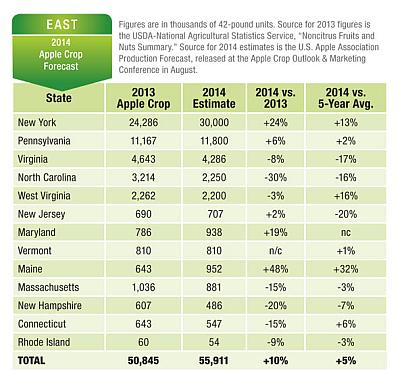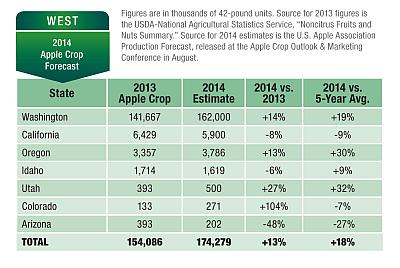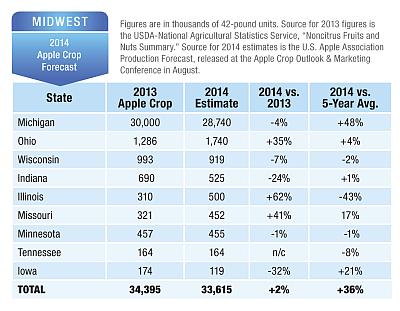Big Apple Crop Expected
 The mood was decidedly upbeat at this year’s USApple national get-together, which is held each August in Chicago. Big crops — 2014 is expected to be the third largest in history according to the USDA — don’t scare industry players as they did in the bad old days, not when the quality of the crop across the country is generally considered to be excellent.
The mood was decidedly upbeat at this year’s USApple national get-together, which is held each August in Chicago. Big crops — 2014 is expected to be the third largest in history according to the USDA — don’t scare industry players as they did in the bad old days, not when the quality of the crop across the country is generally considered to be excellent.
While the USDA Aug. 12 estimate is 259.2 million bushels, up 8% from 2013, the USApple estimate is even higher at 263.8 42-pound bushels/boxes. USApple’s 2014 production forecast is a 10% bigger crop than 2013 and 17% bigger than the 5-year average. (See charts for complete USApple forecasts.) USApple’s forecast has been more accurate in three of the past four years the USDA has issued a forecast. It was unable to do so last year because of the federal government shutdown.
“We’re seeing an increase in per capita consumption which is important with this year’s crop and in years to come,” says Mark Seetin, director, regulatory and industry affairs, U.S. Apple Association.
What’s truly amazing about this year’s crop, said Seetin, is that all that production is being achieved on a lot less land. Per acre yield has increased an astounding 31% over last decade.
In fact, U.S bearing acreage peaked at a high of 468,000 acres of apples in 1995, Seetin said. However, “only” 252 million bushels were produced that year, he noted. This year’s total of 259 million bushels (per USDA) will be produced on just 328,000 acres.
 West Dominates
West Dominates
Washington continues to be the nation’s powerhouse, making the West dominant. Indeed, while the East and Midwest combined will actually be down 1%, the West should be up 13%, according to the USDA. Overall, the East and Midwest should combine to produce one-third of the nation’s crop, while the West should produce the remaining two-thirds.
Besides the increase in per-acre yield, another bright spot, Seetin noted, is that there has been an increase in per capita consumption. That’s important not only for this year’s crop, but for the big crops expected in the years to come.
One other factor that has cropped up recently is the Russian embargo on imports of U.S. products, Seetin said. However, he doesn’t anticipate a big impact, as Russia accounted for just 1.4% of U.S. apple exports last year.
 The forecast of the U.S. apple crop was just one of many presentations at the two-day conference. Here’s a brief look at the remainder.
The forecast of the U.S. apple crop was just one of many presentations at the two-day conference. Here’s a brief look at the remainder.
European Crop
Philippe Binard of the World Apple and Pear Association said the European crop is expected to be 11.9 million tons, the biggest in history, with Poland, Italy, and Hungary having big years. As for varieties, Cripp’s Pink, Gala and Fuji are hot; Spartan, Cortland and Cox Orange are not. Golden Delicious continues to be the most popular variety by a huge margin.
Unlike in the U.S., the Russian ban of Western imports is a big deal, Binard said. It’s especially troubling for Poland, which is expecting its biggest crop in history, 12% larger than the previous record high established last year. Russia represented 35% of European export volume last year.
Chinese Crop
The Russian situation has been the hot topic of conversation among Chinese growers, said Michael Choi, of Zhonglu America Corp. If Russia continues its ban on Western apples, China might be its only source.
“Every year China sets a production record,” Choi says.
This year it’s expected to hit 40.8 million metric tons, up 3% over 2013. However, 40.8 million metric tons would be up 14% over the five-year average.
Canadian crop
Canada’s 2014 apple crop is expected to come in at 21.6 million bushels, up 9.5% over its 5-year average, said Don Werden of the Norfolk Fruit Growers’ Association, Simcoe, Ontario. It is expected to have its biggest apple harvest since 2007. Overall, it’s a clean, quality crop that is sizing up well.
As for varieties, McIntosh, at 31%, or 6.1 million bushels, continues to dominate. Gala, at 9.2% or 2.3 million bushels, is second, and rounding out the top three is Empire, at 6.2%, or 1.6 million bushels.
Mexican crop
The Mexican apple crop will be nowhere close to the huge crop of 2013, said Leighton Romney of Paquimé, Mexico. That crop, 24 million boxes, meant there was not enough bins, CA storage or, believe it or not, labor. This year’s crop, which should come in at 16 million boxes, is a more normal size.
“This should be a good year for U.S. apple exports to Mexico,” says Romney.
Most of the sales of fresh fruit are moving through the supermarket chains. This is a trend that continues to replace the old terminal market and street sales system that has predominated in Mexico. The supermarket chains continue to grow as new stores are opening monthly.
Conference Gets Interactive
Capturing the flavor of the U.S. Apple Association Crop Outlook and Marketing Conference were the editor of American/Western Fruit Grower, David Eddy, and Richard Jones, group editor. In case you missed out, here’s some of the highlights from their Twitter feeds:
@Richard_AVG_AFG: Robert Brackett, Institute for Food Safety & Health: Food Safety Modernization Act emphasizes partnerships btwn regulators and ag. #usapple
@Richard_AVG_AFG: Brackett: Goal of FSMA is increased emphasis on preventive vs. regulatory compliance. #usapple
@Dave_WFG_AVG: David Schmidt, food info expert: 1/4 of Americans negative on GMOs, but 1/4 positive. And 40% of millennials are positive.
@Dave_WFG_AVG: USApple Chairman Chris Britton: Let’s not give up on immigration reform. Call or write your Congressional rep. Get involved!
@Dave_WFG_AVG: Britton: USApple is about so much more than crisis communication. (Think Alar). If apple growers are to have a voice, they must speak as one.
@Richard_AVG_AFG: Gary Baise, OFW Law, on the Clean Water Act: EPA is seeking to stifle and control your production techniques.
@Richard_AVG_AFG: Baise: If the water running off your orchard can contaminate traditional navigable waters, EPA says it can regulate your production.
@Dave_WFG_AVG: Consumer expert Sherry Frey: Produce beverage sales are up, up, up. All fresh fruit and vegetable convenience products are hot.
@Dave_WFG_AVG: Food as medicine is huge. Not just weight management, fiber, heart health. Not all good news for growers. Protein is fastest growing.
@Dave_WFG_AVG: Frey: Hispanic buying power is surging all over the country. Growers should know what Apple varieties they prefer, such as Red Delicious.
@Dave_WFG_AVG: 75% of USA-born Hispanics are under the age of 35. And they care about health. Young Latinas are big in social media, and are early adopters.
For more from the conference check out David Eddy and Richard Jones’ Twitter feeds at @Dave_WFG_AVG and @Richard_AVG_AFG.









